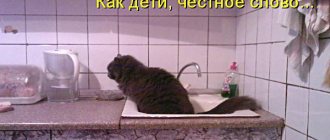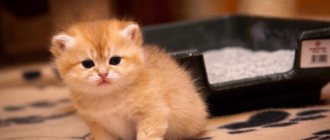The process of litter box training can be quite slow, and you need to be mentally prepared for this. Once in a new home, the pet will experience stress from the change of environment. Before he engages in the training process, he must calm down.
For an adult cat that has already been trained to use the litter box, a change of residence is unlikely to interfere with the ability to navigate the new environment and begin using the toilet correctly. The situation will be much more complicated if a pet from a shelter or from the street appears in the house. Owners need to prepare themselves in advance for the hard work ahead.
How to arrange a cat litter box
If the animal finds it uncomfortable to go to the potty, he will soon choose another, more comfortable place. Therefore, it is important to choose the tray and litter according to your cat's preferences, and then install it in an appropriate location.
Selecting a location
Cats by nature love to hide. Some individuals are embarrassed to go to the toilet in an open space and in front of people. To make your pet as comfortable as possible, you need to place the tray in a quiet place with open access.
Many owners prefer to install the cat litter box in the restroom and leave the door ajar. Another option is a special slot in the door for easy access for the mustachioed. For many families, this is the only acceptable option: unpleasant odors will not spread throughout the house, and the cat will be able to go to the bathroom alone.
If it is not possible to place a tray in the bathroom, you can consider the option of a closed tray-house: it can be placed anywhere in the apartment. The cat will be hidden from prying eyes, and unpleasant aromas will not leak through the thick walls. The only negative is that a kitten is unlikely to like such a house; this is an option for an adult pet.
It is advisable to limit the pet’s movement area to any one room in which the tray is located while the skill is being developed. Then he will quickly learn the place of origin of his needs.
Buying a litter box and cleaning it
It is better to choose a tray from non-electrifying plastic with fairly high sides, about ten centimeters (for a kitten - lower, up to five centimeters). It should be roomy enough so that the pet can comfortably fit in it and be able to cross its paws. If the cat is not from the street, but simply changed its owner, ask the previous owner what kind of litter box the pet used - this will help accustom it faster.
Cats like closed structures in the form of houses more, as they create a feeling of seclusion, but caring for such toilets is much more difficult than a regular litter box. An additional advantage of closed toilets is the presence of special filters that absorb unpleasant odors.
Perhaps the most popular option for cat litter is a plastic tray with a removable grid. But it is not suitable for all pets. Some cats outright refuse to use a tray with stale litter: they are afraid of getting their paws wet.
Therefore, the tray must be cleaned regularly: it is necessary to change the filler and wash the tray with a disinfectant. Be careful not to use chemicals that are too odorous - they may scare the animal away and force you to avoid the potty.
Some cats absolutely need sterile cleanliness: they meow loudly and follow the owner so that he cleans up their feces immediately and immediately. Others are less scrupulous and may use the used tray several times.
Purchasing filler
It is much easier for an outdoor cat to get used to a tray with a filler that resembles sand or sawdust (mineral, wood). At first, you can use sand from the street, into which portions of filler are gradually mixed.
If your pet is accustomed to a particular litter, you should not suddenly change it to another, since you will have to accustom an adult cat to the litter box all over again - he will simply boycott the unfamiliar potty. You need to gradually mix portions of the new mixture into the old one until you completely replace it and the animal gets used to it.
For kittens it is better to use natural (wood, soy, coal) fillers. This is due to the fact that the baby may try the granules on the tooth out of curiosity. Later it will be possible to transfer it to a mineral or silica gel filler.
Tips for the owner
Do not forget about the rules for using fillers:
- Be wary of scented litters (your pet may not like the smell).
- The filler layer should be as thick as possible.
- The scoop is selected based on the type of sand. You should be able to reach all the way to the bottom with the scoop and run it along the bottom. The size of the cells should allow grains of filler to spill freely through the scoop.
- Don't change the litter if your cat likes it (or do it carefully, otherwise she may stop using the litter box).
How to train a kitten to use a litter box
A small pet is just beginning to explore the world and learn new things, so it will not be at all difficult to develop the skill of going to the toilet; training an adult cat to use the litter box is usually more problematic. Under no circumstances should you show aggression or anger if things don’t work out as quickly as you would like.
The optimal age for an animal to begin training is 2-6 weeks. The main guarantees of success: the correct choice of tray, its installation location and filler. A kitten should not buy a tray with very high sides “for growth”, otherwise he will refuse to use it due to inconvenience. For the same reason, it is better not to install a toilet-house as the first tray.
A kitten goes to the toilet more often than an adult animal. If you notice that the baby is restless, scratching his paw on the floor, walls or furniture, or spinning in one place, immediately carry him and put him in the tray. Do not create a fuss while doing this; the pet may get scared. You can help the cat and, taking his paws in your hands, scratch the litter.
Wait until the baby does his business, and then praise him. You should not give him a treat: encouragement with your voice and stroking will suffice.
Sometimes it is enough to carry out such manipulations several times, and the animal understands what they want from it. It happens that it takes much more time, please be patient.
If the kitten misses, there is no need to scold him or scream: he will be scared and is unlikely to understand what happened. Point him to the puddle, and then take the baby to the tray.
Some owners are lucky and do not face the problem of toilet training their animal. If the kitten they adopted grew up with a cat mom, chances are she taught him everything.
Why doesn't an adult cat use the litter box?
Some cats are homeless or feral. This means they never received the socialization needed to become a pet. Sometimes a kitten is born into the family home but is rejected by its mother.
This means he was never taught basic functions. Some cats are also abused by other pets. This could make them afraid to use the litter box due to the smell. Another animal could even "stand guard" over the litter box, preventing your cat from entering.
© shutterstock
How to train an adult animal: algorithm of actions
Adult felines are very scrupulous and picky about the toilet. They are disturbed by noise and various external stimuli. To fulfill their natural needs, they instinctively choose hard-to-reach, secluded corners, for example, places behind a closet or behind a sofa, where it is quiet and there are no prying eyes. Therefore, while the animal adapts, it is better to play it safe and block off such areas.
There is no difference in learning ability between male and female cats, especially for sterilized pets.
When working with an animal, you should take into account that each pet has its own character and level of intelligence. Some people learn to use the litter box fairly quickly, while others need time to form the desired habit. Difficulties usually arise when training adult pets - especially if the cat came into the house from the street, where there were no rules for the discharge of natural needs.
To develop the necessary skill in your pet, you need to place the cat litter box correctly. It should always be available and located in a convenient location. A bathroom or a warm loggia are the most suitable options.
The animal must be explained what a tray is and for what purposes it is used. This must be done patiently and calmly, without getting irritated, much less without any physical influence. Cats are very smart creatures; they respond well to changes in voice intonation. Take advantage of this. Barbaric methods like poking your nose into a puddle will not speed up the learning process, but, on the contrary, will complicate the task, increase the duration of adaptation and turn your pet into a frightened creature.
A scheme for training an adult cat to use a tray to obtain the fastest results may look like this:
- The need to relieve oneself in animals usually occurs after eating. For the first time after a cat appears in the house, do not leave it unattended. When the animal has eaten, carefully take it to the tray. Sit near the cat, wait. When she relieves herself, praise and pet her. But don’t rush to clean the litter box – let your pet form an olfactory connection.
- The animal may want to go to the toilet not immediately after a meal, but at another time. Signs of this are as follows: the animal begins to worry, sniffs corners, and scratches the floor. In this case, you need to take the pet to the litter box, wait until everything is over, and praise it.
- If it happens that you didn’t notice and the cat did its “dark” business in the room, then do not rush to punish it. Blot the puddle with a napkin and take it to the tray. Let your pet smell it. If the cat came into the house from the street, sprinkle the puddle it made with sand and take the wet sand to the tray. Give your pet a chance to explore the litter box and form an olfactory connection. The place where the puddle was must be washed with perfume or strong-smelling substances: vinegar, alcohol, kerosene. You can drop and rub a couple of drops of essential oil with the aroma of citrus or lavender on the washed area.
- It happens that the pet himself chose a place for the toilet, and it does not coincide with where the tray is located. In this situation, there is only one way out - put the tray in the place that the cat chose. Once the habit is established, begin to gradually move the tray so that over time it ends up in the place you want. The movements need to be made small: 1-2 centimeters per day.
- Don't take risks and don't leave outdoor shoes in the access area. The smells of the street can provoke the animal, and it will be very difficult for you to rid your favorite shoes of cat odors.
- If another cat previously lived in the house, treat the area where her litter box was located with a strong-smelling compound. Cats' sense of smell is unique. A new resident may be able to smell the scent even if several years have passed and will be tempted to mark the area.
- In pet stores you can purchase a special spray for toilet training a cat, which is recommended for treating the litter box. There are also sprays with a repellent odor, which are recommended for treating risk areas, such as the hallway.
If the cat knows where the tray is, but periodically goes to another place, you need to take a good look and look for the reason. Perhaps something is bothering your pet.
Tray selection
Looking at a one-month-old kitten, many people think that it needs the smallest tray.
You can learn how to determine the age of a kitten from the article
But it is not so. Taking care of the baby in this case is quite understandable, but it should be remembered that the animal will grow quite quickly.
The weeks will fly by unnoticed: today the kitten is a month old, and after, it would seem, a couple of days he is already 1.5 months old, a little more and he has reached two months of age.
Before you even blink your eye, the furry baby will turn into a respectable cat that no longer fits in its toilet.
And if you are the happy owner of one of the large breeds , such as Maine Coon , Ragdoll or Savannah , then in this case the smallest toilet is out of the question.
If you rely on the advice of veterinarians, then you should immediately purchase a tray with sides of about 8-10 cm: the pet can easily overcome them, the main thing is that he wants to do it.
But the height should not be too high.
In any case, as the animal grows, you will have to change its litter box to a larger one once or twice.
And in order to accustom a kitten to the litter box fairly quickly, it is necessary that it meets the following requirements:
- complete absence of foreign odors;
- the material from which the toilet is made should not oxidize upon contact with feces;
- The tray should not rattle when the kitten tries to cover its “footprints”, otherwise it will scare it.
The baby should feel comfortable and safe
Thus, it turns out that the most suitable option is a plastic tray.
It may come complete with a grille or be without it.
What to buy is up to you, but here you need to take into account that a toilet with a grate is more convenient to use.
This way, liquid feces will pass through it, and your pet’s paws and fur will remain clean.
This aspect is especially relevant when your apartment contains a representative of one of the long-haired breeds, for example, a Persian , Siberian , or Norwegian cat .
Is it possible to teach a cat to go to the toilet?
Some cat owners do not want to install a litter box in their apartment; they prefer that the animal go to the toilet on the toilet. But you won’t be able to completely avoid using a cat potty, since you can accustom a cat to a litter box, including an outdoor one, only through an “intermediate object,” namely a litter box. An animal that is not familiar with the litter box will not be able to learn to relieve itself on the toilet.
If your pet clearly knows that her business needs to be done in the tray in a strictly designated place, you can move on to changing habits - going to the toilet to the toilet. Do everything gradually. If you rush, you'll have to start all over again. Move the tray every day by 1-2 cm, moving it towards the location of the toilet.
For the next stage of training, prepare a large stack of paper, newspapers or magazines. Place newspaper under the tray after each use. Do not put too much at once - no more than 1 cm at a time. Otherwise, the pet may begin to show character and go on strike, leaving puddles on the floor.
In the process of raising the structure, the amount of filler should decrease. The best option is ꟷ if you didn’t use it from the very beginning. Be careful about the stability of the stack of newspapers. If the structure collapses at the most crucial moment, the animal may become frightened, and all training will go down the drain.
When the tray is at the level of the toilet, secure the result and let your pet finally get used to it. After a few days, you can move the tray onto the toilet itself and remove the pile of paper. Make sure everything is installed securely. It is better if you raise the seat; without plastic elements, the design is more stable, and this is very important.
At the last stage, you need to remove the tray; it is better to take it out of the apartment altogether so that the animal cannot find it by smell. When the cat wants to go to the toilet, she will be forced to use the toilet. After all, the tray had been standing there for the last few days.
There are times when your pet refuses your proposed plan at this stage. There may be signs of protest on the floor. In this case, you should return the tray to the toilet and try again.
There is another option for completing training - longer, but more reliable. To implement it, cut the bottom in the tray, gradually increasing the diameter. When the hole is the same as in the toilet, you can simply throw away the sides from the tray. And the cat is guaranteed to do his business in the desired place.
Some owners resort to a special tray attachment for the toilet - it also does the job well. But the attachment is used at the last stages of training, so a regular tray will still be needed at first.
There are two important rules for toilet training an adult cat: the toilet lid should always be up and the door to the toilet should always be open.
Training aids
Since all owners want to accustom their cat to the litter box quickly and forever, they often begin searching for aids. Special sprays can be good helpers. There are two types of pharmaceuticals:
- with an attractive effect;
- with a repellent effect.
The principle of operation of the first type of products is based on the fact that their smell attracts the cat, forcing it to go to the toilet in the right place. The secret of this effect is simple: it contains urea, in other words, urea. Therefore, some cat owners do not want to purchase an aerosol; they simply moisten a napkin with the animal’s urine and place it in the right place. But using a spray is much more convenient, and such preparations are inexpensive. The product should be sprayed around the tray: on a piece of paper left nearby, or on the filler itself.
Sprays with a repellent effect are used to treat potentially at-risk areas, such as shoes, places behind furniture, and rugs. It is also recommended to use them in areas where the animal has already left a puddle.
All specialized products are absolutely safe for cats. But there are people who prefer folk remedies, for example, lavender oil. Use a few drops in the place where the animal gets into the habit of going to the toilet - the aroma repels cats well.
Citrus fruits also seem unpleasant to cats - you can leave the peels of oranges or tangerines in the place where the animal has shitted several times.
Which filler is better?
The choice of filler is a purely individual question for each cat. Some pets do not recognize granules with flavorings, some are unpretentious and do without any filler at all. First of all, the owner should pay attention to the harmlessness of sand for the cat's litter box. A high-quality filler meets the following requirements:
- practically no dust;
- does not have too strong fragrance;
- does not pose a threat when eaten;
- quickly absorbs moisture;
- does not stick to the animal's paws.
Poor quality can cause an allergic reaction in cats and their owners, leaving a “swamp” in the tray.
For an adult animal, you can use wood pellets, bentonite clay or silica gel, depending on the pet's choice.
Reasons for possible difficulties
When developing the skill of defecating in the right place, difficulties sometimes arise. They can be caused by various reasons. Just watch your pet to understand why training is so difficult.
Sometimes it happens that an animal went to the toilet in the right place, and then suddenly stopped. In this case, you need to understand what causes this behavior and how to re-accustom an adult cat to the litter box.
Disease
The most dangerous and unpleasant reason for refusing to go to the toilet is illness. If something is bothering your pet, he may change his behavior in an attempt to let you know that something is hurting him.
In some cases, due to illness, he simply forgets where to go to the toilet, or this process causes him severe discomfort and pain. This may be urolithiasis, kidney failure or cystitis. If you notice changes in the animal's behavior, anxiety, lethargy, or other symptoms of the disease, you should contact your veterinarian. After the course of treatment, your pet will recover and, most likely, will return to its usual toilet.
Stress
Litter box refusal can also be caused by stress. It is worth considering that cats, like people, have different personalities and stress tolerance. Therefore, each requires a special approach. Limit the animal from stress as much as possible, be patient, do not punish the cat for mistakes - and very soon she will understand what you want from her.
It happens that changes in life circumstances cause anxiety in an animal. For example, a new person has appeared in the family or someone has died. In this case, try to devote as much time as possible to your pet. If you have a second cat, you should designate a litter tray for each pet.
New tray or new place
Cats are animals that do not tend to change their habits; they quickly become attached to their territory and certain places. Therefore, when changing the tray, a problem may arise such as refusal to go to the toilet in the usual place. What can we say about moving?
If you change the tray, sometimes you have to start training again - be prepared for this. If you are planning a move, make sure the new location has privacy areas for the cat and elevated areas for observation. The fewer reasons for stress the animal has, the better the adaptation will be and the fewer problems will arise with the toilet.
The period of sexual hunting
Sometimes difficulties are caused by the so-called mating season. It’s quite easy to check whether a cat leaves marks intentionally or whether there is another reason for his behavior. If the pet becomes more restless - it looks from the outside as if he is looking for something - and the animal urinates in small portions on a vertical surface, then we can definitely talk about the cat’s sexual activity. The solution is castration or regular mating with a cat.
Psychological reasons
There is an opinion that a cat can leave puddles out of spite, thus showing its stubbornness and discontent. Not all experts recognize this possibility - there are supporters of the theory that cats do not have consciousness, therefore, they do not know how to take revenge. In fact, many owners know that a cat can take a shit if it is offended - but almost immediately. Animals are definitely not capable of delaying revenge and serving it cold.
If your pet is loved and caressed, but he still walks in the wrong place, first of all you need to rule out the disease. If everything is fine in this regard, you need to decide how to most gently accustom an adult cat to the litter box again, taking into account the identified reason: often puddles or piles become an attraction for the owner’s attention. A couple of examples:
The cat feels sad when left alone for a long time. The owner returning late finds a fragrant “gift” in an unexpected place. Getting a second pet will solve the problem.
The cat likes or doesn’t like something. If he wants to go for a walk, but they don’t let him in, he can shit under the door. Or there is a desired item in the closet, which means the cat can go near the door of this closet.
More complex causes are difficult to identify. Sometimes monitoring an animal takes several weeks, or even months. But patient owners cope with the problem, no matter how ingenious it may be.
What not to do
Under no circumstances should you punish your pet. If you start poking your animal’s nose into his feces, he will not understand that he is being scolded for going to the toilet in the wrong place; he will simply regard this as a punishment for a completed physiological act. In the future, the cat will hide from you in more secluded places in order to carry out its “dirty deeds”.
You should not forcefully hold your pet in the tray while waiting for him to go to the toilet. The animal will simply get scared and will avoid the tray.
The cat will definitely understand what they want from him - you just need to be affectionate towards your pet. It is not an easy task to accustom an outdoor cat to a litter box, and the result will depend on how you behave. The main key to success is patience; after a certain amount of time, the cat will definitely figure out what to do, and you will find happiness and peace.
Do you like the article? 198










